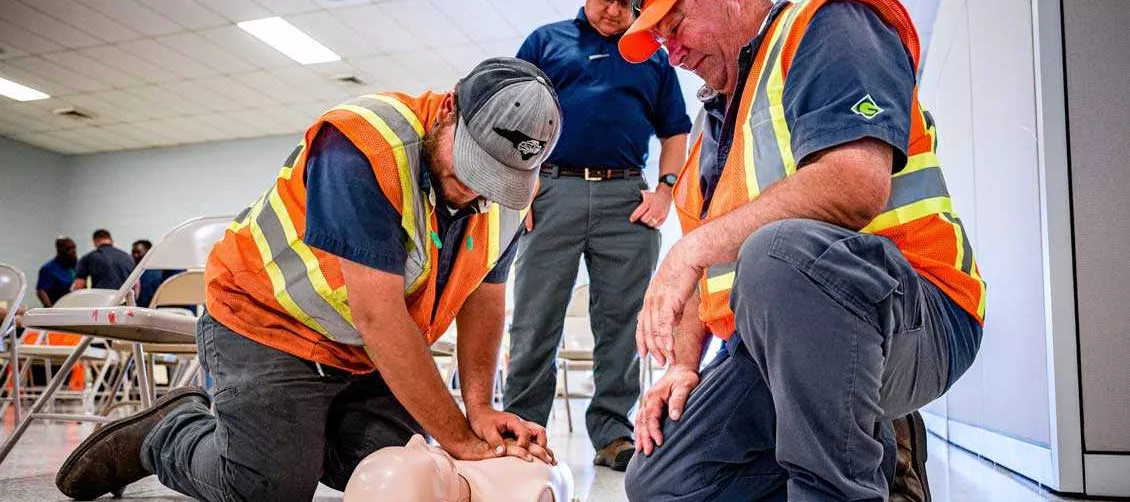Why Your Business Needs HLTAID011 First Aid Training in Adelaide

Posted on May 28, 2024
Importance of First Aid Courses and CPR Training
In today's corporate landscape, the emphasis on workplace safety and corporate responsibility has never been greater. Going beyond mere compliance, companies are increasingly recognising the value of investing in the safety of their employees and a key aspect of this commitment is ensuring that employees are equipped with essential first aid skills.
HLTAID011, also known as “Provide First Aid,” is a comprehensive First Aid training course that incorporates both HLTAID010 (Provide basic life support), and HLTAID009 (Provide cardiopulmonary resuscitation). This course is designed to equip individuals with the knowledge and skills necessary to respond effectively to common first aid emergencies.
HLTAID011 training covers a wide range of critical first aid skills, including (but not limited to) cardiopulmonary resuscitation (CPR), managing wounds and bleeding, responding to allergic reactions, and administering basic life support. This first aid course also encompasses a range of vital first aid competencies such as burn treatment and aiding individuals in emergency choking and breathing distress situations. HLTAID011 first aid course participants will also learn to recognize the signs of shock, safely handle fractures, and respond to abrupt medical conditions like strokes, seizures, and heart attacks.
By providing employees with this training, businesses empower them to respond confidently and competently in medical emergencies, both within the workplace and beyond. For more detailed information on what this first aid course covers, please visit the HLTAID011 First Aid course & CPR training page.
First Aid Course and CPR Training: Benefits to Companies
Enhanced Safety Culture
Investing in first aid training in Adelaide demonstrates a company's commitment to fostering a culture of safety and well-being. Employees gain vital first aid knowledge and expertise while becoming more aware of potential hazards in the workplace and react suitably to avert mishaps. This proactive stance on safety has the potential to result in a notable decrease in workplace occurrences, fostering a safer and more productive work setting.
Reduced Liability
Employers can be held liable for damages if they neglect to make available access to adequate first aid training and equipment. However, by offering appropriate first aid training and equipment, and producing evidence of having done so, employers can help protect themselves from potential legal liabilities and claims for negligence. In the event of a workplace emergency, having trained employees who can provide immediate first aid assistance can reduce the severity of the outcomes and potentially save lives; which in the long term contributes to the financial health of the business.
Decreased Workers' Compensation Claims
A first aid course and CPR training means employees can respond effectively to accidents, leading to fewer workplace injuries. As a result, companies often experience a reduction in workers' compensation claims, which can translate into lower insurance costs and legal expenses associated with claims management.
Lower Insurance Premiums
Insurance providers often offer discounts to companies that have comprehensive safety programs in place, including first aid training for employees. By demonstrating a commitment to workplace safety, companies can negotiate lower insurance premiums, resulting in significant cost savings over time.
Minimised Downtime
When employees are injured on the job, it often leads to downtime as they recover and are unable to work. By providing prompt and safe first aid treatment, minor injuries can potentially be prevented from escalating into more severe medical conditions. This allows the employee to recover more quickly and return to work sooner, therefore minimising any downtime and administration, and helping reduce any impact on productivity levels.
Improved Response Times
In a medical emergency, every second counts. Trained employees can initiate first aid measures quickly and confidently manage emergency situations and provide an appropriate first aid response to a colleague while waiting for professional medical help to arrive. A quick response time significantly improves the outcome for individuals who have a medical emergency in the workplace.
Improved Employee Retention and Morale
Investing in employee safety with a first aid course in Adelaide demonstrates a company's commitment to its workforce's well-being. Employees are more likely to feel valued and satisfied when they know their employer prioritizes their safety, leading to higher retention rates and lower recruitment and training costs associated with employee turnover. Consequently, this can foster a more positive workplace environment and increase employee retention. For the employees who have completed their First Aid HLTAID011 training, the added confidence from the knowledge gained can extend beyond the workplace, positively impacting their personal lives and communities.
Scenarios Where HLTAID011 First Aid Training is Beneficial
Sudden Medical Emergencies
Whether it's a heart attack, stroke, or severe allergic reaction, having employees trained in first aid can mean the difference between life and death. For instance, providing CPR to an individual who has ceased breathing can help maintain the activity of their heart and brain until professional medical assistance is on the scene. Swift and effective intervention can stabilize the individual's condition until help arrives. Sudden cardiac arrest can happen anywhere, including the workplace. Immediate CPR and the use of an automated external defibrillator (AED) can dramatically improve the chances of survival. Having employees trained in HLTAID011 increases the likelihood of a positive outcome in such emergencies.
Accidents and Injuries
In high-risk environments such as construction sites or manufacturing facilities, accidents and injuries can occur unexpectedly. For example, in the event of a fracture or sprain, applying a cold compress can help reduce swelling and pain, while correctly bandaging a wound can help defend against infection and prevent blood loss. In the unfortunate event of electrocution or sudden loss of consciousness, employees may need CPR to be administered until professional medical help arrives. By having trained employees who can administer first aid and CPR to injured colleagues it helps prevent further complications and ensures they receive the immediate care they need.

First Aid in the Workplace
Employers are typically obligated to comply with occupational health and safety standards such as those set by WorkSafe to ensure a safe working environment. First aid requirements will vary from one workplace to the next, depending on the nature of the work, the type of hazards, the workplace size and location, as well as the number of people at the workplace. These factors must be considered when deciding what first aid arrangements need to be provided.
According to the Safe work Australia, businesses are defined as either low risk workplaces or high-risk workplaces. A low-risk workplace is a workplace where workers are not exposed to hazards that could result in serious injury or illness such as shops, a library, or offices. Potential work-related injuries and illnesses requiring first aid in these environments would be minor. A high-risk workplace is a workplace where workers are exposed to hazards that could result in serious injury or illness and would require first aid. For example, high risk workplaces are ones in which workers use hazardous machinery, substances, or potentially dangerous forms of work such as welding. Another example is if the employee is at risk of a fall that will result in serious injury, such as a construction site.
How many trained first aid staff should be in your business per employees is based on factors such as the size of the workforce, the nature of the workplace hazards, and the level of risk. The following ratios are recommended:
- Low risk workplaces – one first aid trained staff member for every 50 workers
- High risk workplaces – one first aid trained staff member for every 25 workers.
First aid trained staff should hold nationally recognised Statement(s) of Attainment issued by a Registered Training Organisation (RTO) for the nationally endorsed first aid unit(s) of competency. Getting HLTAID011 First Aid Training with an RTO for your employees is easy with ATEC. The training itself is conducted onsite at either our Ottoway or Lonsdale locations and only requires staff to be off-site for one day. This short time away from the office will yield many benefits to your business in the long term. There is some preliminary online theory and assessment required before commencing the first aid training course but that can be done in the employees’ own time.
Investing in HLTAID011 first aid courses in Adelaide for employees is not just a legal requirement or a box to check for compliance. It's a decision that can protect lives, enhance workplace safety culture, and reduce potential risks for businesses. By empowering employees with essential first aid skills, companies demonstrate their commitment to corporate responsibility and create safer workplaces.
Do you have a question about any of the information here?
 Make an Enquiry
Make an Enquiry
Stay up to date with ATEC news and announcements
Subscribe for our email updates


